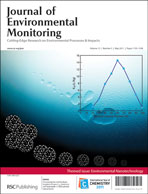C60 molecules are well as hydrophobic compounds with a high KOC value. But what happens when fullerene molecules are released into the environment?
Mohsen Forouzangohar and Rai Kookana from the Commonwealth Scientific and Industrial Research Organisation have expanded on previous work that considered environmental C60 sorption on a purely molecular basis and assumed phase partitioning into soil organic matter is the main mechanism for the sorption of the hydrophobic C60 molecules. They have shown that they may actually exist in the form of nano-C60 clusters in the environment – rather than as C60 molecules – and that hydrophobic interactions of this compound with soil organic matter are not likely to be the dominant mechanism governing its mobility in the environment. Instead, net surface charge and hydrophilic interactions are expected to play a much more significant role, which could lead to much higher aqueous concentrations of the fullerenes in the environment than previously anticipated.
This interesting article is the cover article from our themed issue on Environmental Nanotechnology and it’s free to access for 6 weeks:
Sorption of nano-C60 clusters in soil: hydrophilic or hydrophobic interactions?
Mohsen Forouzangohar and Rai S. Kookana
J. Environ. Monit., 2011, 13, 1190-1194
DOI: 10.1039/C0EM00689K











